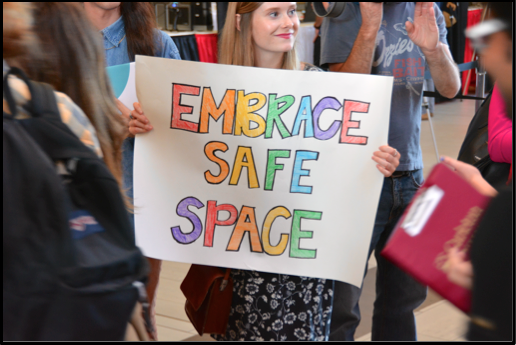Staff Writer, Allie Akers
Ever since the Presidential election in 2016, “Safe Spaces” have been popping up all over the country, mostly on college campuses. Schools and students have felt they are now necessary due to fear, anxiety, and hate, and these rooms have been fiercely debated over the past couple of years. Many believe that safe spaces in schools are needed, due to the strong differences in opinions that divide many Americans. Others find them unnecessary, feeling that safe spaces coddle people instead of exposing them to other viewpoints and that they violate the First Amendment right of free speech. As many students at Voyager Academy High School have noticed, this year we have our own safe space room on campus, located in the English II / AP Lang classroom.
Ms. Barber, originally from Missouri, is a new teacher at Voyager Academy High School. Before she came here, she was teaching at a boarding school for kids with ADHD. The Viking Tide interviewed Ms. Barber, asking about the Safe Space sticker outside her classroom door. She said that at her former school, “There was a hate act by a staff member targeted towards the Q.S.A (Queer Straight Alliance). As the advisor of the club, I wanted to help educate people how to love others for who they are.” She then started training for safe schools in NC, specifically for the LGBTQ community, which is where she acquired the Safe Space sticker. When asked who was the safe space for, in which she responded, “It’s for anyone who feels different or threatened for who they are, whether they’re students or staff.” When asked how the students respond to the idea of a Safe Space, Ms. Barber said, “Some students don’t grasp the weight of it. They think it’s a joking term which tends to be a connotation with this generation. They’re just misinterpreting it. However, the students in my classroom are happy and participate, which is a positive effect of the Safe Space.”
The Viking Tide interviewed some students on safe spaces and whether they think we need one in Voyager or not. Sebastian Diaz is a sophomore who attends Voyager Academy High School. “I think safe spaces, theoretically, should not have to exist. People should be able to talk or practice whatever they want within reason without fear of persecution.” Austin Shepard is also a VAHS sophomore. He stated, “I don’t agree with them. They infringe on people’s right to the first amendment right to express how they feel and only let one group express their opinion. They only let people with the same idea express their opinion.” The Viking Tide then asked these two students if they could imagine using a safe space. Austin replied with; “No, I feel that everyone should be able to express how they feel openly. I enjoy open discussions and debates with opinions on either side.” Sebastian says, “I don’t feel like I’d personally need one. I mean I honestly don’t care what people think about me or what I say.” The final questions Viking Tide asked was do they think Voyager needs a safe place. Austin’s stance on this question is, “No, because students of Voyager should be allowed to have open debates between one another.”
I believe that we do need these safe spaces because they help people who may feel threatened and unsafe to be able to express themselves freely and without fear of repercussion. As a student at Voyager, I have not personally felt victimized. However, when our civics class has debates on current events, I get very worked up, passionate, and emotional, even when these issues don’t directly affect me. Conversely, students with opposing viewpoints also can get emotional as well, and often, the debate becomes very heated and can get intensely personal. I honestly can’t imagine what it would feel like to be someone who is affected by the subject of one of these debates and is debating or fighting just to be themselves. (Recent debates have included DACA and the meaning and use of the Confederate flag.) Because of this, I absolutely understand the usefulness of these rooms. There is a great diversity of people who attend this school and a safe space should always be available, so everyone can truly feel safe to be themselves and know that they are supported unconditionally, even when they feel targeted or victimized. Having a safe space harms no one, but it can benefit anyone.
APA Citations:
Furedi, F. (2017, January 05). Campuses are breaking apart into ‘safe spaces’. Retrieved September 26, 2017, from http://www.latimes.com/opinion/op-ed/la-oe-furedi-safe-space-20170105-story.html
SafeSpace. (n.d.). Retrieved September 26, 2017, from https://www.safespace.org/
Domestic Violence and Sexual Assault Program. (n.d.). Retrieved September 26, 2017, from http://ncsafespace.org/
Shulevitz, J. (2015, March 21). Opinion | In College and Hiding From Scary Ideas. Retrieved September 26, 2017, from https://www.nytimes.com/2015/03/22/opinion/sunday/judith-shulevitz-hiding-from-scary-ideas.html?mcubz=0
Photo:
Simo, O., & Simo, A. O. (2016, September 10). University Safe Spaces and Trigger Warnings:The Downfall of Higher Ed. Retrieved September 25, 2017, from http://oldsimo.com/education/univeristy-safe-spaces-trigger-warnings/


